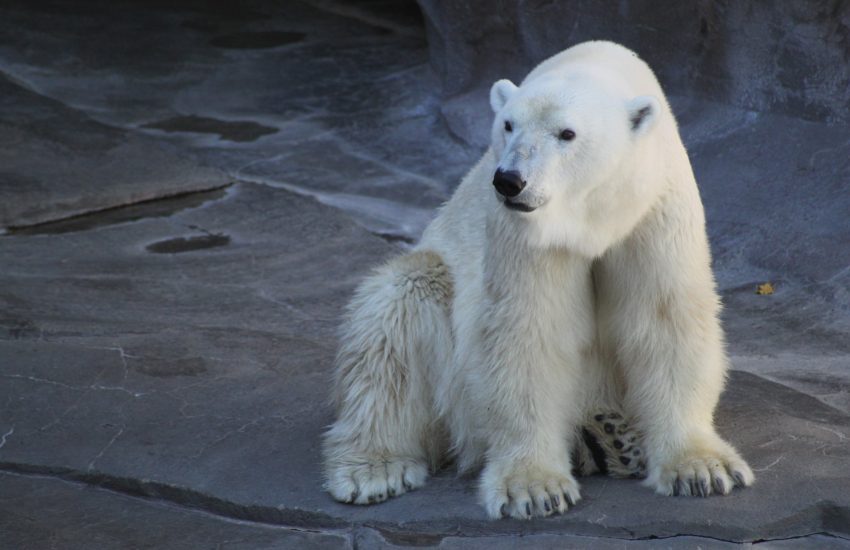Save the climate
Believers of the MMCC (Man-Made Climate Change) religion like Greta Thunberg, AOC, Al Gore and many others want to save “the” climate. One has to wonder, which climate they mean. Do they really believe that today’s or yesterday’s climate is “the” climate, i.e. the one and only climate that is supposed to exist on earth in order to accommodate a specific form of human civilization? Do these people not know that the only thing that is constant about the climate of this planet is that it has been constantly changing for 4.5 billion years?
They claim that recent comparatively minor changes in earth’s climate are caused by human activities. Do they not know that there have been far more dramatic changes in earth’s climate while people did not even exist?
Computer models
If we rather generously assume that man has existed on earth for about one million years and if we equate the 4.5 billion years of geo-history with a 24-hour day, then mankind has existed for about 19.2 seconds of earth-time – not long enough for mankind to ever have experienced earth’s mean climate, which was overall much warmer than the relatively cool period we are currently in.
The entire man-made-global-warming theory is mainly based on computer models, which have been repeatedly proven to be incapable of adequately accommodating the most important “greenhouse gas” – water vapor and clouds. To this present day, efforts to develop computer models, which can reliably process and prognosticate cloud formation and combine it with other climate factors in a meaningful manner, have failed.
A computer model is just a theory about reality. Theories are tested by observation and experiment. Unfortunately, their creators mainly strive to prove their correctness, selecting their corroborating “facts” in the light of the very theory they are trying to prove. This approach is profoundly unscientific.
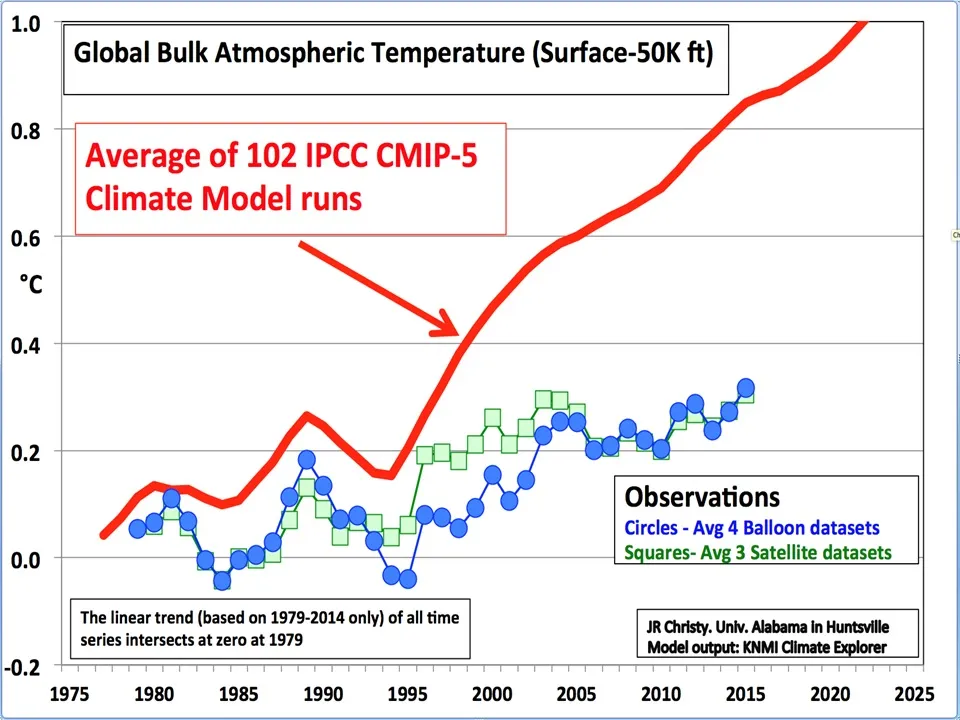
(Data by John R. Christy, Ph.D., University of Alabama in Huntsville.)
What is science?
When a scientist develops a theory, his or her first and foremost duty is to make every possible attempt to prove that the theory is wrong. This is done by formulating prognostic sentences that are based on the theory to be tested and that can be falsified by a protocol sentence about an experiment or an observation.
For example, if your theory is “In a perfect vacuum, all material objectsfalltoearthwiththesamespeed”, you can test your theory by dropping objects in a vacuum and measuring the speed, with which they fall to earth. As long as you measure the same speed for all tested objects, you may consider your theory as relatively corroborated, albeit not as verified. If you measure only one different speed for one object, your theory is falsified.
An assertion based on which no prognostic sentences about the results of experiments or observations can be formulated that could be falsified by a protocol sentence about inter-subjectively observable reality is not a scientific theory.
A theory cannot be tested using another theory. Theories with an unlimited latitude of truth cannot be tested at all. An example for this is the old German proverb: “Whenever the rooster crows on the crap, the weather will change, or it will stay as it is.” This may be an eternal truth, but due to the “or” it is also a theory that cannot be falsified.
Where do we get the temperature data from
Until approximately 1980, data about the temperature of the atmosphere came almost exclusively from weather stations in the USA and other industrialized countries. In 2016, Joseph Abrams published an article about the results of a critical examination of 1,219 weather stations in the USA and found that nearly 90% of them were compromised and did not meet the government requirement that they must be a minimum distance away from artificial heat sources. Weather stations that had been built on the green meadow were found standing right next to the AC exhaust of a hotel several years later. The resulting increase in temperature did not say anything about the atmosphere but a lot about urbanization. Also, while we talk about “global” temperatures, the weather stations from which temperature data were derived, did not cover the globe uniformly. When the Soviet Union collapsed, the global atmospheric temperature average went up, since no data were coming from Russia and since the data that had been coming from the Soviet Union were mostly in the lower range. Beginning in the late 1980s, atmospheric temperature data came increasingly from satellite measurements, which also have their problems but seem overall relatively more reliable.
Unfortunately, data were also falsified and manipulated. Just remember the “East-Anglia Scandal” when climate scientists deliberately manipulated their data to show global warming to suit their political agenda (“Do not ask what you can do for Global Warming. Ask what Global Warming can do for you.”). Interestingly, the latest research about the temperature development in Antarctica that seems to indicate that its ice shield is melting after it had been found to increase for decades has been conducted by – you guessed it – the East Anglia University!
Or Michael Mann’s “Hockey-Stick-curve”, which showed a dramatic increase in atmospheric temperatures since 1850 but was based on the dendrochronology of just one tree, incorrect statistics, and the denial if the Little Ice Age.
The Internet has unfortunately perverted into a disinformation highway. It has become increasingly difficult to determine, whose data are correct and whose are incorrect. All things considered, there seems to have been a temperature increase of the atmosphere of about 0.4 degrees Celsius between 1950 and 2017. Projected against earth’s climate history, a miniscule change, which is supposedly caused by human emissions of greenhouse gases, mainly CO2 (often falsely called “carbon”).
Why is CO2 called a “Greenhouse Gas”?
The concept of CO2 being a “greenhouse gas” in the sense of a gas, which entraps heat from the sun in the atmosphere thus making the atmosphere warmer, is based on a misunderstanding. CO2 has been traditionally used in greenhouses by farmers and nurseries to boost plant growth, not to increase the temperature in the greenhouse. Greenhouses are heated by heating systems or by the sun, but not by CO2. In fact, the capability of CO2 to store heat decreases exponentially and reversely proportional to its concentration in the atmosphere.
There is only a very small quantity of CO2 in the atmosphere. 99% of the atmosphere are nitrogen and oxygen. The remaining 1% is trace gases, among them CO2, which makes up only 0.05% of the atmosphere at a 500 ppm (parts per million) concentration. Only a very small portion of this is the result of human activity – if any.
While the role of CO2 as a “greenhouse gas” that heats up the atmosphere is limited, it is certainly the staple food of all plant life. Since CO2 has been increasing in the atmosphere the “green mass” of all plant life on earth has increased by an estimated 20%. It is rather ironical that those who advocate for reducing the staple food of plants in the atmosphere call themselves “green”. The more CO2 the atmosphere contains, the greener our world will be.
Natural vs. “man-made” CO2
By far most of the CO2 that ends up in the atmosphere is the result of natural events and processes. Only a very small amount of CO2 is the result of human activities. A distinction between man-made and nature-made CO2 by means of isotopes can only be made in statu nascendi, i.e. when ancient CO2 is just discovered or when recent CO2 is just “made”. Once the CO2 arrives in the atmosphere, the distinction is no longer possible, since CO2 molecules are not permanently associated with isotopes. And plants do not care, anyway, whether they “consume” natural or man-made CO2.
There clearly is a “CO2 cycle”. Carbon is oxidized into CO2 and plants split it again, as part of photosynthesis, into carbon and oxygen. The CO2 that is deposited in the world’s large CO2 deposits such as the oceans, coal, lignite, petrol oil, and natural gas got there through extraction by plants or microorganisms. Humans “make” CO2 mainly by releasing it again from one of these deposits, into which it got from the atmosphere. Almost all CO2 that humans release into the atmosphere came originally from the atmosphere.
The main source of human “made” CO2 is ammonia production. Ammonia is used to make fertilizers that are essential to feeding the world’s population and it is made from natural gas. The CO2 that is set free during ammonia production was originally extracted out of the atmosphere by the microorganisms that generated the natural gas. In other words: we do not really “make” CO2. We just recycle it. How much or little CO2 is present in the atmosphere at any given point in time depends on how much CO2 is retained in and released from the major CO2 deposits either by nature or by man.
The climate keeps changing
During earth’s 4.5 billion years of history, its climate has continuously changed in most radical ways. During the Precambrian (ca. 550 million years before today) the CO2 concentration in the atmosphere was nearly 16-times higher than today (ca. 8,000 ppm) and during the Ordovician (ca. 450 million years before today) the CO2 concentration in the atmosphere was still ca. 8-times higher than today (ca. 4,000 ppm). Earth’s temperature was much warmer und plant growth was much stronger than today. There was less ice and the oceans were higher.
All of this happened without any human interference because there were no humans around. During and after the last ice age, CO2 concentrations in the atmosphere dropped to nearly 200 ppm. Nota bene: At approximately 180 ppm all plant life on earth will die and with it most other life forms.
Beer contains CO2. If you let your beer get warm, the CO2 escapes from it into the atmosphere. The same happens with the oceans, the world’s largest CO2 deposit.
Greenland and Antarctic ice core analyses show unequivocally that any increase of CO2 in the atmosphere follows (i.e. does not precede) the warming of the oceans by about 600 – 2000 years. The warming of the oceans is mainly caused by a warming of the atmosphere. In other words, for CO2 to be the cause of atmospheric warming, it would have to be its own cause and effect, which is factually impossible and logically nonsense.
The only thing that has ever been constant about climate is that it constantly changes. During its history, earth froze over completely at least once and has changed repeatedly between warm and cold periods. Several recent ice ages are documented. The first one lasted from ca. 590 K – 540 K years before today. The Australopithecus dates to about 600 K before today. Pre-homo sapiens groups appear at the end of the second interglacial period. Homo sapiens appears at the end of the last ice age, which ended about 18-20 K years ago. Around 3,500 years before today, the so-called Minoan Warm Period began, which lasted ca. 400 years. At that time, the mean atmospheric temperature was about 3 degrees Celsius higher than today. The Roman Optimum lasted from ca. 200 BC until about 500 AD, with average temperatures still about 2 degrees Celsius above today’s. Then, temperatures decreased again. This period is called the Dark Ages Cooling and it lasted from ca. 500 AD to ca. 900 AD, followed by the Dark Ages Warming, which lasted approx. from 900 – 1300 AD.
Late in the 10th century, the Vikings began to settle Greenland and around 1300 AD they had to abandon it again, because the ice came back. All without any industrialization or human interference whatsoever. Then came the Little Ice Age with the Maunder Minimum (around 1700). Subsequently, it got warmer again as the Little Ice Age ended around 1850. Yet, it is still cooler today than it was during the Medieval Warm Period, the Roman Optimum, and the Minoan Warm Period. And the melting of the ice in Greenland started before any significant industrialization had begun.
The Milanković forces
It is therefore reasonable to assume that we are currently in the fourth interglacial period and headed for another ice age. The last interglacial period lasted approximately 60 K years. The last ice age ended approximately 20 K years ago. If this pattern continues, the next ice age will probably begin in about 5000-8000 years.
It appears that climate on earth is mainly determined by cosmic drivers like the proximity of the Milky Way to other galaxies, the proximity of our solar system to other systems within our galaxy, the intensity and direction of sun activity, the elliptical shape of earth’s trajectory around the sun, by the ecliptic, and by the Milanković forces, which are cycles of changes in the Earth’s movements that directly affect Earth’s climate.
The Milanković forces are named after the Serbian engineer and mathematician Milutin Milanković. The eccentricity, axial tilt, and precession of Earth’s orbit vary in several patterns, resulting in 100,000-year ice-age cycles over the last few million years. The Earth’s axis completes one full cycle of precession approximately every 26,000 years. ‘Precession’ is the term for the wobble of earth’s axis around itself. At the same time, the elliptical orbit rotates more slowly, leading to a 21,000-year cycle between the seasons and the orbit. In addition, the angle between Earth’s rotational axis and the normal to the plane of its orbit moves from 22.1 degrees to 24.5 degrees and back again in a 41,000-year cycle. Currently, this angle is 23.44 degrees and decreasing.
Milanković’s theory was mostly ignored for decades but has recently been indorsed by many climatologists. If his theory holds water, the world is approaching another ice age.
Under certain conditions, the magnetic center of the sun can actually be pulled out of its mass center and even out of the sun altogether. When this happens, the main sun activities may occur on the side of the sun that faces away from the Earth. Accordingly, protuberances and particle rain etc. can change greatly and with them atmospheric ionization and cloud formation, which is our main “greenhouse gas”.
Tectonic shift and continental drift
One aspect of climate change has been grossly neglected in the climate debate: the shift of the tectonic plates and continental drift. We know that during earth’s history the continents were not always located where they are today. At least six times in geo-history, continents have bunched up together to form one single landmass: Kenorland, Nuna, Rodinia, Pannotia, Gondwana, Pangea.
These shifts have had an enormous impact on climate. Consider this: we find glacier tracks in the equatorial tropical rainforest regions of South America and Africa and some of the world’s largest coal deposits are located in Antarctica! This means that about 35–55 million years ago Antarctica must have had a tropical vegetation and that the tropical rainforest regions of South America and Africa must have been covered by glaciers.
The only plausible explanation for this is that at some point in geo-history these regions must have moved to other locations on the globe compared to where they are today. This could only have been caused by continental drift.
Both Greenland and Antarctica and in fact the entire earth were ice-free for millions of years without any human interference.
The American and the European tectonic plates are currently moving away from each other at a speed of about 1-2 inches per year. This trend will likely continue for several million years. Geo-history allows predicting that the trend will then reverse itself and the continents will bunch up to form a single landmass again like they did several times before. Large portions of land that exist today will disappear in the process.
This world is a hostile environment and it does not care whether it suits humans or not. Compared to these macro-factors, human climate-relevant activities shrink to a quantité négligeable.
The Null Hypothesis
It seems unreasonable to assume that, while climate change on this planet was determined by natural and cosmic drivers for 4.5 billion years, humans, who have been around for just a few seconds of the earth-day, should now be the main drivers of climate change. Would it not seem more reasonable to first disprove the Null-Hypothesis, i.e. the claim that all climate change is caused by natural non-human forces, and provide evidence that those forces that have determined earth’s climate for so long do no longer do so?
Seems to me that if forces of nature are moving Earth toward another ice age, we should perhaps ask ourselves what type of climate would be a greater problem for humankind: a warmer one or a colder one?
Where do people go on vacation, to warmer or colder regions? If it gets significantly colder on earth, the ocean levels will drop in some areas, except in those, where tectonic plate shifts compensate for it. However, most of the land won by sinking ocean levels would be quickly claimed by the advancing ice. It is also easier for humans to compensate for heat than to compensate for cold. We cannot grow anything on ice.
A study published in the British journal The Lancet analyzed data on more than 74 million deaths in 13 countries between 1985 and 2012. Of those, 5.4 million deaths were related to cold, while 311,000 were related to heat, which means that 17.4 times more people died from cold than from heat.
If the climate warmed up, Antarctica and Greenland would become inhabitable and arable land again and the increased CO2 in the atmosphere would grow more trees, raise ground water levels, and produce greater agricultural yields.
The science is in — all scientists agree. End of discussion.
Believers in man-made climate change often argue that “all scientists” or “97% of all climate scientists” agree that there is significant man-made climate change. This goes mainly back to an article by Naomi Oreskes that appeared 2004 in the journal “Science”. Oreskes claimed to have examined 928 papers reported by the database of the Institute for Scientific Information in scientific publications between 1993 and 2003. She searched using the search words “global climate change”. Oreskes, a socialist historian, concluded that 75% of the authors surveyed supported the IPCC’s view that man is responsible for more or less all warming of the atmosphere over the past 50 years, and that none of the authors directly dissented.
Her article appeared in a peer-reviewed journal but the article itself had not been peer-reviewed. Oreskes’ article was not a scientific article. It was an opinion piece and the editors never asked to see her database. She inexplicably overlooked hundreds of publications by well-known global warming skeptics such as John Christy, Sherwood Idso, Richard Lindzen, Habibullo Abdussamatov, Lord Monckton, Fred Singer, Willie Soon, or Patrick Michaels. Oreskes also failed to read the entire publications. She only looked at the abstracts, which often overstate some issues or remain silent on important questions like e.g. whether human-made climate change would be beneficial or not. The 928 papers considered by Oreskes constituted only one thirteenth (7.7%) of the climate literature known at the time, when she made her survey.
The medical researcher Klaus-Martin Schulte later used the same database as Oreskes and found that fewer than half endorsed the IPCC claim of “man-made global warming” and only 7% explicitly so. In a 2009 study, Doran and Zimmerman sent a two-minute survey to 10,257 “earth scientists” and got 3,146 responses. They explicitly excluded from the study all those scientists who think that the sun or planetary dynamics may have something to do with earth’s climate. This means that they excluded most solar scientists, space scientists, cosmologists, physicists, meteorologists, and astronomers. By contrast, they included many scientists from fields that are unrelated to climatology. They clearly selected their target audience in the light of their bias. Several other similarly flawed studies have also been debunked.
By contrast, 31,487 scientists signed a petition to the US government in 1997 requesting that the notion of manmade global warming be refuted. Here is the petition:
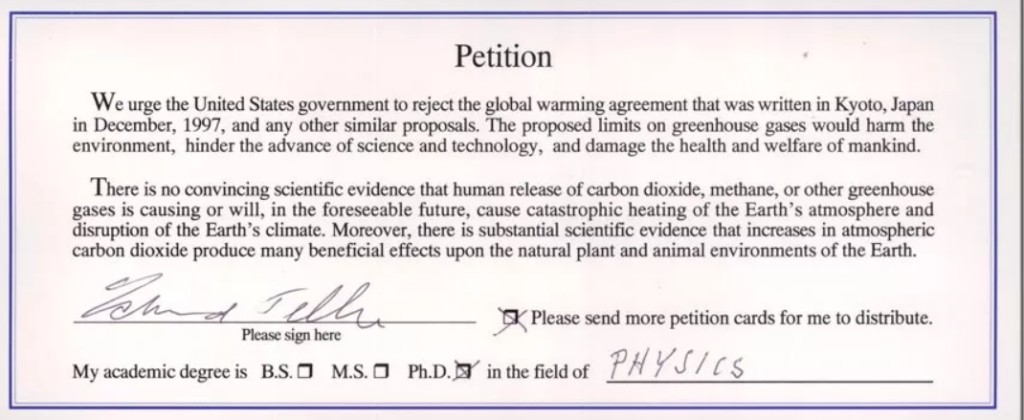
The text reads: “We urge the United States government to reject the global warming agreement that was written in Kyoto, Japan, in December 1997, and any other similar proposals. The proposed limits on greenhouse gases would harm the environment, hinder the advance of science and technology, and damage the health and welfare of mankind. There is no convincing scientific evidence that human release of carbon dioxide, methane, or other greenhouse gases is causing or will, in the foreseeable future, cause catastrophic heating of the Earth’s atmosphere and disruption of Earth’s climate. Moreover, there is substantial scientific evidence that increases in atmospheric carbon dioxide produce many beneficial effects upon the natural plant and animal environment of Earth.”
These scientists were not just skeptics. They were convinced that the human-caused global warming hypothesis is without scientific validity and that government action on the basis of this hypothesis would unnecessarily and counter-productively damage both human prosperity and the natural environment of the Earth. (N.B.: according to Bloomberg, the cost of Obama’s United Nations Global Warming Treaty came in at $12.1 trillion or $484 billion dollars yearly.)
As a matter of principle – science is not decided by majority vote. The validity of general scientific theories is determined by their falsifiability and their level of corroboration. Each time an attempt to falsify a theory fails, the theory is corroborated, but not verified. Theories are tested by experiment and observation and not by vote or by other theories. Accordingly, consensus of scientists – pro or contra – is not a valid criterion of scientific truth.
False cooling and warming prophesies
1912 – “Prof. Schmidt Warns Us of an Encroaching Ice Age” – New York Times
1923 – “Scientist says Arctic ice will wipe out Canada” – Professor Gregory of Yale University, American representative to the Pan-Pacific Science Congress, – Chicago Tribune
1923 – “The discoveries of changes in the sun’s heat and the southward advance of glaciers in recent years have given rise to conjectures of the possible advent of a new ice age” – Washington Post
1932 – “If these things be true, it is evident, therefore that we must be just teetering on an ice age” – The Atlantic magazine, This Cold, Cold World
The imminent ice age did not come.
Numerous predictions about global warming have been made based on the faulty computer programs used by the IPCC. Most of these predictions have been proven false or grossly exaggerated.
In 1987, James Hansen, one of the early Climate alarmists, predicted, based on his computer models, that within 15-20 years the atmospheric temperature would increase by more than 3 degrees Celsius (6.3 degrees Fahrenheit). According to the NOAA, the actual warming was 0.36 degrees Celsius or 0.64 degrees Fahrenheit over this 20-year period. About 10% of what Hansen had predicted.
In 1988, Hansen predicted that in 2050 global atmospheric temperatures would be 6-7 degrees F higher on average than they were in 1988. Washington DC would have 85 instead of 35 days a year with temperatures over 90 F. Ocean levels would rise by about six feet. Hurricanes, tornados, floods, and droughts would increase, and the maximum strength of hurricanes would increase by about 50%.
30 years after Hansen’s predictions, the atmosphere has warmed by about one degree F. If you believe the ocean level rose by six feet, take trip to NYC and check. Between 1992 and 2017 Greenland and Antarctica lost a combined 6.4 trillion metric tons of ice, which raised the sea levels globally by 17.8 mm = 0.7 inch.
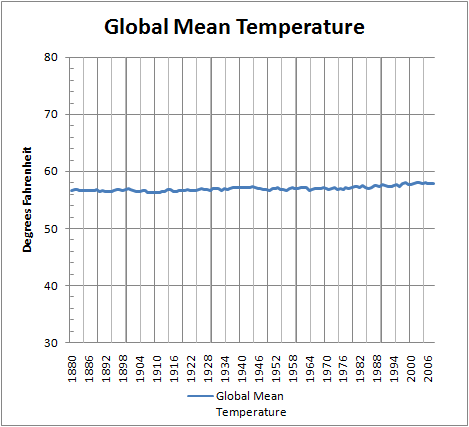
That we have some degree of global warming is to be expected, since we are just coming out of the Little Ice Age and are probably in an interglacial period.
The Polar Bears are dying
For quite some time, the polar bear has served the climate change religion as an emotional symbol that evokes pity with the sorry fate of the cute bears and anger about the inconsiderate consumers of fossil energy, whose egotistic desire to heat and cool their houses and travel in their own vehicles they blame for global warming. Global warming in turn is supposed to cause the Arctic ice to melt destroying the habitat of the polar bear.
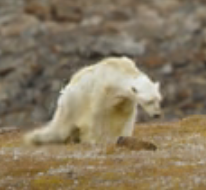
This tearjerker photo was published by National Geographic under the headline “This is what climate change looks Like” and it has had a terrific propaganda effect worldwide (2.5 billion viewers). The photographer, Cristina Mittermeier, later conceded that she failed to determine why this bear was in such bad shape.
“We had lost control of the narrative,” she admitted.
Mittermeier explained the climate change deception in a piece titled “Starving-Polar-Bear Photographer Recalls What Went Wrong” for the magazine’s August issue. “I can’t say that this bear was starving because of climate change. Perhaps we made a mistake in not telling the full story – that we were looking for a picture that foretold the future and that we didn’t know what had happened to this particular polar bear.” she wrote in National Geographic.
However, while the lie went viral, the correction went mostly unnoticed.
Unfortunately, the facts are inconveniently incompatible with the sob story. This was probably an old polar bear or a sick one. Like all other creatures, polar bears age and eventually die. They die mostly from starvation when they become too old to hunt successfully. Like it or not. It’s nature’s way.
Climate apologists claim that the polar bear’s further existence is threatened by climate change. However, polar bears have not always been polar bears. As genetic analyses show, they developed fairly recently, about 0.5 million years ago, from brown bears. Their development was probably the result of a group of brown bears having been isolated in the North when the climate turned colder.
Currently, polar bears are doing quite well. Based on the 2018 “State of the Polar Bear Report”, there are 20 bear populations, most of them in Canada. For 11 of them, data are not definitive. Three probably had declining populations. Two had increasing populations. The remaining populations were stable.
Here are the current polar bear population estimates based on counts from the International Bear Association, International Wildlife, and the IUCN Polar Bear Study Group:
| Year | Polar Bears |
|---|---|
| 1950 | 5,000 |
| 1965-1970 | 8,000 — 10,000 |
| 1984 | 25,000 |
| 2005 | 20,000 — 25,000 |
| 2015 | 22,000 — 31,000 |
In other words: the world’s polar bear population grew by over 520% in the past 65 years during which the CO2 levels in the atmosphere have constantly risen.
Just like polar bears were not always polar bears, the Arctic region was not always covered with ice. In fact, most of the time during geo-history planet earth was completely ice free and the average climate was much warmer than it is today. For millions of years, even Antarctica was ice free and was covered by dense vegetation. 5.3 million years ago, the northern Arctic region and Greenland had hardly any ice and Greenland was covered by a dense spruce and pine forest, while sea levels were about 60 feet higher than they are today. 4 million years ago, there was as much ice in the arctic regions in winter as currently exists in summer and during the summer, the Arctic was ice-free.
2.6 million years ago, tectonic plate shifts forced the closure of Arctic Ocean gateways, like the Bering Strait, and thermally isolated the region. That restricted the Arctic’s circulation, causing a build-up of fresh water and conditions favorable to the formation of major ice sheets.
From that point onward, the climate became continuously cooler and ice sheets grew as far south as present-day St. Louis and New York City.
Polar bears will probably be in good shape regardless of whether our climate turns warmer or colder. If it turns colder, they will be better prepared to cope with it than we humans. If it turns warmer, there is a good chance that polar bears will be able to develop back into brown bears.
According to Al Gore’s scary predictions about rising oceans, New York City should be already 10 feet under water. The oceans are rising alright. They have been rising for centuries. According to Singer/Avery (2007), sea levels have been rising by 4-5 inches over the past 100 years (appr. 0.05 inch per year) and are likely to continue rising at this pace for the coming 100 years. However, we do not know with certainty, whether the rise of the water level in relation to the land is due to actually rising water or to sinking land or both. Interestingly, Al Gore, who had predicted that the ocean levels would rise by 20 feet, bought a beachfront mansion and so did the Obamas.
Tornados have not increased. Neither have hurricanes. It is true that the damages caused by hurricanes have become greater in dollar terms. But not because we have more or more devastating Hurricanes. It is because people build more and more expensive structures in harm’s way and government mandated insurance rules support this trend. Katrina did not foreshadow the future. No F3 hurricanes in 15 years.
If drastic action is not taken, Al Gore predicted over 10 years ago, there would be a “True planetary emergency”. It did not happen. But Al Gore became the world’s first climate billionaire.
In spite of China and India having both drastically increased their CO2 outputs, there has been no significant increase of global atmospheric temperature since 1998. The Arctic ice is still there and 2015 has seen the largest re-freezing of the Arctic ice in recent years. Antarctic ice has steadily increased with the exception of the Antarctic Peninsula, where a narrowly defined reduction of ice occurred, probably due to underwater volcanic activity.
The ENTIRE global warming between 1880 and 2006 has been less than six tenths of one degree.
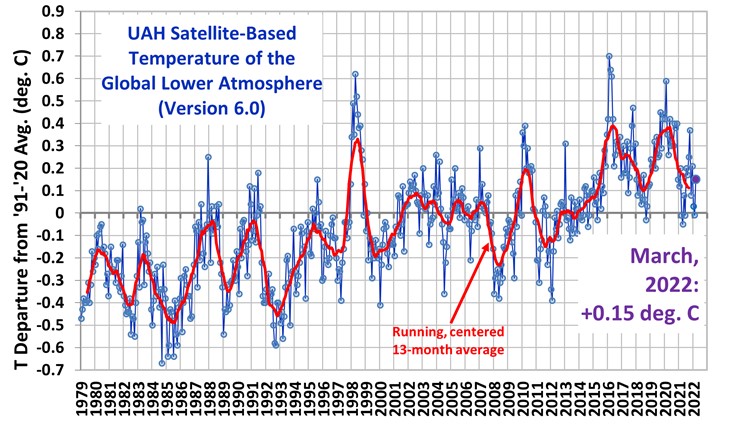
Above, the Global Warming Advocates’ own chart, rendered in actual degrees.
What we should do and what not
Mankind can relatively easily adjust to a warmer climate, but if we are really moving toward another ice age – regardless of what may cause it – we would face a much bigger calamity than global warming. Would it, therefore, not be prudent to invest our resources into preparing for these colder conditions and to develop the means that would allow mankind or at least a significant part of it, to adjust to and survive another ice age?
We should move our cities and other centers of population away from the shores of the Oceans, of lakes, and rivers. We should relocate urban settlements like New Orleans away from a low-lying location to places with a higher elevation. We must make reasonable use of fossil fuels, while we still have them, and use the grace period to develop new types of energies and fuels like nuclear fusion and liquid hydrogen. Instead of wasting enormous amounts pf resources of inefficient forms of energy such as wind and solar systems, we should put together and fund a national or even an international energy and fuel taskforce with the sole objective of developing new, sustainable, and affordable forms of energy. We should put together a similar group to develop new types of fertilizers that do not have a contaminating effect on soil and water, and we should explore cold temperature agriculture. Perhaps another group should develop new materials and methods of thermal insulation. And if we can really warm up earth’s climate by increasing CO2 in the atmosphere we should do so as much as possible, because a warmer world is a better world.
Instead, we are destroying our economies, our technical civilization, and our energy and food supplies through unreasonable expenses and restrictions and we are creating public hysteria through irrational fear-mongering climate change ideologies that are trying to prevent the unpreventable.
We, the human species, can probably survive almost any climate change, but only if we deal with it in a smart way and prepare for it in advance. If we fail to do so, we will be “mendeled” out by nature like many other species before us that could not fast enough adapt to changes in their natural environment.
